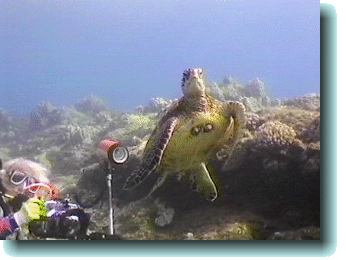
In 1996, Polzbarney was at home as usual.
37K JPEG
Hawaiian green sea turtles are called ‘honu' by the Hawaiians. ‘Honu' is a beautiful word and it is important to say it softly and with love in your voice.
This is a story about a young honu we called Polzbarney.
We first met Polzbarney in July, 1995. He made his home right under a little ledge in a coral garden. Because he lived so close to shore, he was sure to have a steady stream of visiting snorkellers.
Polzbarney soon learned exactly how much distance to keep between himself and a human--close enough to give people a good look, but not close enough to touch. In this way, Polzbarney became well known to many people as "the first sea turtle I ever saw."
In 1996, Polzbarney was at home as usual, and we sighted him on our first dive that year. He had grown a lot, but there seemed to be white "pimples" in both his eyes.

| In 1996, Polzbarney was at home as usual. 37K JPEG |
We knew that his chances of staying healthy were not good at Honokowai. So many other young turtles had lived there and developed a tumor disease called fibropapilloma. We were worried.
Again in 1997, we sighted Polzbarney on the first dive. This time it took only one look to know for sure he was sick. His eyes had beginning tumors, but there was something worse.
His eyes had beginning tumors, but there was something worse. 52K JPEG | 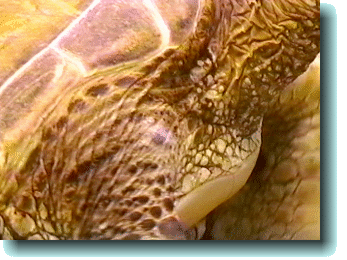
|
There were several white spots on his right shoulder and one was an "eruptive" tumor. "Eruptive" means the tumor is pushing out of the skin and looks like a white zit... Polzbarney had the smallest of tumors--but tumors they were.
We were saddened by Polzbarney's tumors. The disease destroys young honu within two or three years of them showing the first signs of being sick. The odds are not good for Polzbarney.
In 1998 Polzbarney was worse than ever. His eye tumors had grown in size and the tumor on his right shoulder was now about the size of a walnut! He now had two more beginning tumors: one under his throat, another on his left shoulder--more and more bad news.
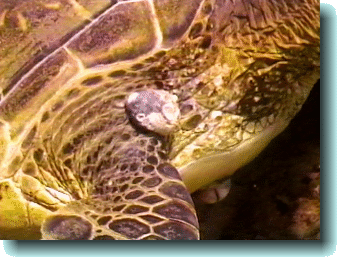
| ...the tumor on his right shoulder was now about the size of a walnut! 53K JPEG |
We did get some good news, though. The expert on Hawaiian green sea turtles lives just two islands away. His name is George Balazs and he decided to visit Polzbarney. He brought his research team and equipment with him.
First they had to capture him. Polzbarney didn't like that at all!
First they had to capture him. 25K JPEG | 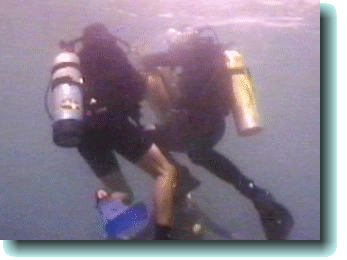
|
Then George measured him. The measuring instrument is called a "tree caliper" and it is used to measure how big around trees are! George uses it to measure how big around turtles are! (This is called being creative.)
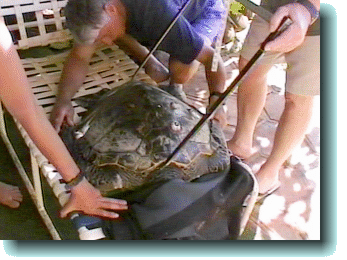
| Then George measured him. 49K JPEG |
Next George inspected Polzbarney's eyes. George said he has two small tumors in each eye. (We knew that already.)
...he has two small tumors in each eye. 35K JPEG | 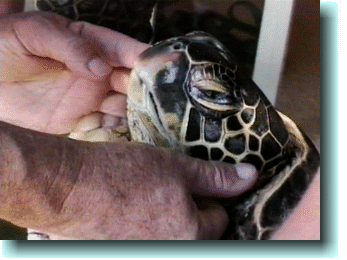
|
After that, George looked inside Polzbarney's mouth. George said he has a tumor in his throat. (This, of course, we didn't know! We hope they won't grow any bigger. Big tumors make it hard for a turtle to breathe and eat.)
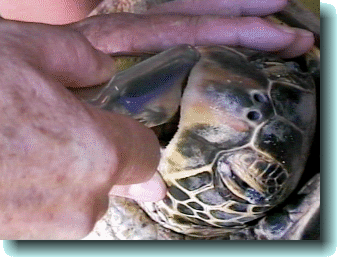
| Then George looked inside Polzbarney's mouth. 39K JPEG |
Finally, George took some tumor samples. George said he would send them to a lab. Maybe what the biologists learn from Polzbarney's tumors will help someone understand the disease better. This is our hope.
Next George took some tumor samples. 41K JPEG | 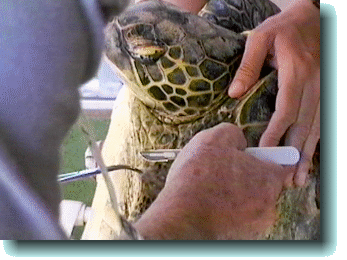
|
Through the whole examination Denise Ellis, George's diving partner and colleague, stroked Polzbarney and kept him comforted. If you are a turtle it is not easy to be out of the ocean, flat on your back with people poking at you. Denise did a great job keeping Polzbarney calm so George could inspect him.
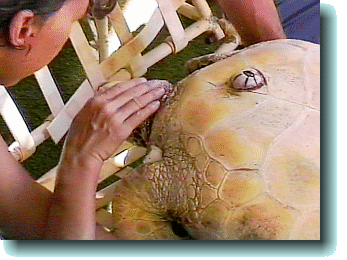
| Denise did a great job keeping Polzbarney calm. 49K JPEG |
When the examination was finished George and Marc Rice (dive partner and high school teacher) took Polzbarney back to the beach...
George and Marc Rice took Polzbarney back to the beach. 46K JPEG | 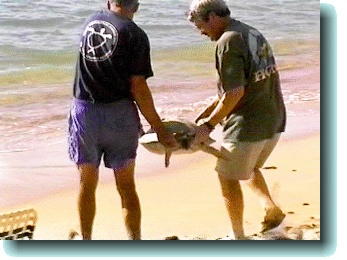
|
...and let him go.
Being taken from his home must have been frightening for Polzbarney. We were afraid that it might scare him into finding a new place to live. This didn't happen, however, and we were happy to see him back under his ledge for the rest of the summer.
Polzbarney is growing bigger despite his disease. He will probably move further away from shore someday soon. We hope that he won't leave until we have a chance to see him in 1999. If we do, we'll tell you how he's doing. Although we hope he will be getting better, we know that most young turtles who get tumors do not. All we can do is hope.
As we promised, we have prepared a page describing the latest news about Polzbarney. There is some good news but also some bad news. You can read all about the latest news in our article titled For the Love of Polzbarney.
 For the Love of Polzbarney
For the Love of Polzbarney
Last modified 00/04/01
Send comments or corrections to webmaster@turtles.org